Thermo-Economic Assessment of a Gas Microturbine-Absorption Chiller Trigeneration System under Different Compressor Inlet Air Temperatures
Abstract
1. Introduction
2. Methodology
2.1. Description of the System
2.2. Thermodynamic Modeling
2.3. Thermo-Economic Analysis
2.4. Exergy Cost Balance and Thermo-Economic Indicators
3. Results and Discussion
3.1. Energy and Exergy Analysis
3.2. Exergy Destruction
3.3. Cost Rate of Exergy Destruction
3.4. Relative Cost Difference and Exergo-Economic Factor
4. Conclusions
Author Contributions
Funding
Acknowledgments
Conflicts of Interest
Abbreviations
| HRSG | Heat Recovery Steam Generator |
| ARS | Absorption Refrigeration System |
| CRF | Capital Recovery Factor |
| DC | Direct cost |
| CI | Capital Investment |
| PEC | Purchase Equipment Cost |
| CC | Combustion Chamber |
| TCI | Total Capital Investment |
| OM | Operation and Maintenance |
| Nomenclature | |
| Specific cost | |
| Entropy | |
| Associated cost | |
| Exergy (kJ/s) | |
| Specific enthalpy | |
| Mass flow | |
| Heat transfer | |
| Universal gas constant | |
| Pressure (bar) | |
| Rotational engine speed (rpm) | |
| Temperature | |
| Time | |
| Power (kW) | |
| fraction | |
| Area | |
| COP | Performance coefficient |
| Annual interest rate | |
| n | Equipment’s lifetime |
| capital investment cost (USD/s) | |
| Relative cost | |
| The exergoeconomic factor | |
| Greek Letters | |
| Maintenance factor | |
| Heat recovery efficiency | |
| Total operation time (Hr) | |
| Subscripts | |
| Exergetic | |
| Motor | |
| Molar | |
| Condenser | |
| Absorber | |
| Evaporator | |
| Chemical | |
| Physical | |
| Standard or reference | |
| Destruction | |
| Lost | |
| Produced | |
| Molar | |
| Supplied | |
| Pump size | |
References
- Urbanucci, L.; Testi, D.; Bruno, J.C. Integration of reversible heat pumps in trigeneration systems for low-temperature renewable district heating and cooling microgrids. Appl. Sci. 2019, 9, 3194. [Google Scholar] [CrossRef]
- Ramírez, R.; Gutiérrez, A.S.; Eras, J.J.C.; Valencia, K.; Hernández, B.; Forero, J.D. Evaluation of the energy recovery potential of thermoelectric generators in diesel engines. J. Clean. Prod. 2019, 241, 118412. [Google Scholar] [CrossRef]
- Valencia, G.; Duarte, J.; Isaza-Roldan, C. Thermoeconomic analysis of different exhaust waste-heat recovery systems for natural gas engine based on ORC. Appl. Sci. 2019, 9, 4017. [Google Scholar] [CrossRef]
- Al Moussawi, H.; Fardoun, F.; Louahlia-Gualous, H. Review of tri-generation technologies: Design evaluation, optimization, decision-making, and selection approach. Energy Convers. Manag. 2016, 120, 157–196. [Google Scholar] [CrossRef]
- Lecompte, S.; Lemmens, S.; Huisseune, H.; Van den Broek, M.; De Paepe, M. Multi-objective thermo-economic optimization strategy for ORCs applied to subcritical and transcritical cycles for waste heat recovery. Energies 2015, 8, 2714–2741. [Google Scholar] [CrossRef]
- Aprhornratana, S.; Eames, I. Thermodynamic analysis of absorption refrigeration cycles using the second law of thermodynamics method. Int. J. Refrig. 1995, 18, 244–252. [Google Scholar] [CrossRef]
- Florides, G.A.; Kalogirou, S.A.; Tassou, S.A.; Wrobel, L.C. Modelling, simulation and warming impact assessment of a domestic-size absorption solar cooling system. Appl. Therm. Eng. 2002, 22, 1313–1325. [Google Scholar] [CrossRef]
- Shirmohammadi, R.; Soltanieh, M.; Romeo, L. Thermoeconomic analysis and optimization of post-combustion CO2 recovery unit utilizing absorption refrigeration system for a natural-gas-fired power plant. Environ. Prog. Sustain. Energy 2018, 37, 1075–1084. [Google Scholar] [CrossRef]
- Valencia, G.; Núñez, J.; Duarte, J. Multiobjective optimization of a plate heat exchanger in a waste heat recovery organic rankine cycle system for natural gas engines. Entropy 2019, 21, 655. [Google Scholar] [CrossRef]
- Szargut, J.; Morris, D.; Stewar, F. Exergy Analysis of Thermal, Chemical and Metallurgical Processes; Hemisphere Publishing: New York, NY, USA, 1988. [Google Scholar]
- Kotas, T. The Exergy Method of Thermal Plant Analysis; Anchor Brendon Ltd.: London, UK, 1985. [Google Scholar]
- Kaynakli, O.; Kilic, M. Theoretical study on the effect of operating conditions on performance of absorption refrigeration system. Energy Convers. Manag. 2007, 48, 599–607. [Google Scholar] [CrossRef]
- Martínez, H.; Rivera, W. Energy and exergy analysis of a double absorption heat transformer operating with water/lithium bromide. Int. J. Energy Res. 2009, 33, 662–674. [Google Scholar] [CrossRef]
- Kaushik, S.C.; Arora, A. Energy and exergy analysis of single effect and series flow double effect water–lithium bromide absorption refrigeration systems. Int. J. Refrig. 2009, 32, 1247–1258. [Google Scholar] [CrossRef]
- Gomri, R.; Hakimi, R. Second law analysis of double effect vapour absorption cooler system. Energy Convers. Manag. 2008, 49, 3343–3348. [Google Scholar] [CrossRef]
- Rosiek, S. Exergy analysis of a solar-assisted air-conditioning system: Case study in southern Spain. Appl. Therm. Eng. 2019, 148, 806–816. [Google Scholar] [CrossRef]
- Pourfayaz, F.; Imani, M.; Mehrpooya, M.; Shirmohammadi, R. Process development and exergy analysis of a novel hybrid fuel cell-absorption refrigeration system utilizing nanofluid as the absorbent liquid. Int. J. Refrig. 2019, 97, 31–41. [Google Scholar] [CrossRef]
- Alanne, K.; Saari, A. Sustainable small-scale CHP technologies for buildings: The basis for multi-perspective decision-making. Renew. Sustain. Energy Rev. 2004, 8, 401–431. [Google Scholar] [CrossRef]
- Al-Sulaiman, F.A.; Hamdullahpur, F.; Dincer, I. Trigeneration: A comprehensive review based on prime movers. Int. J. Energy Res. 2011, 35, 233–258. [Google Scholar] [CrossRef]
- Mohammadi, S.M.H.; Ameri, M. Energy and exergy analysis of a tri-generation water-cooled air conditioning system. Energy Build. 2013, 67, 453–462. [Google Scholar] [CrossRef]
- Fontalvo, A.; Pinzon, H.; Duarte, J.; Bula, A.; Quiroga, A.G.; Padilla, R.V. Exergy analysis of a combined power and cooling cycle. Appl. Therm. Eng. 2013, 60, 164–171. [Google Scholar] [CrossRef]
- Diaz, G.A.; Forero, J.D.; Garcia, J.; Rincon, A.; Fontalvo, A.; Bula, A.; Padilla, R.V. Maximum power from fluid flow by applying the first and second laws of thermodynamics. J. Energy Resour. Technol. 2017, 139, 032903. [Google Scholar] [CrossRef]
- Marimón, M.A.; Arias, J.; Lundqvist, P.; Bruno, J.C.; Coronas, A. Integration of trigeneration in an indirect cascade refrigeration system in supermarkets. Energy Build. 2011, 43, 1427–1434. [Google Scholar] [CrossRef]
- Hawkes, A.D.; Leach, M.A. Cost-effective operating strategy for residential micro-combined heat and power. Energy 2007, 32, 711–723. [Google Scholar] [CrossRef]
- Valencia Ochoa, G.; Acevedo Peñaloza, C.; Duarte Forero, J. Thermoeconomic Optimization with PSO Algorithm of Waste Heat Recovery Systems Based on Organic Rankine Cycle System for a Natural Gas Engine. Energies 2019, 12, 4165. [Google Scholar] [CrossRef]
- Bejan, A.; Tsatsaronis, G.; Moran, M. Thermal Design and Optimization; John Wiley & Sons: Hoboken, NJ, USA, 1995; ISBN 0471584673. [Google Scholar]
- Kizilkan, Ö.; Sencan, A.; Kalogirou, S. Thermoeconomic optimization of a LiBr absorption refrigeration system. Chem. Eng. Process. 2007, 46, 1376–1384. [Google Scholar] [CrossRef]
- Lian, Z.T.; Chua, K.J.; Chou, S.K. A thermoeconomic analysis of biomass energy for trigeneration. Appl. Energy 2010, 87, 84–95. [Google Scholar] [CrossRef]
- Mago, P.J.; Hueffed, A.K. Evaluation of a turbine driven CCHP system for large office buildings under different operating strategies. Energy Build. 2010, 42, 1628–1636. [Google Scholar] [CrossRef]
- Ghaebi, H.; Karimkashi, S.; Saidi, M.H. Integration of an absorption chiller in a total CHP site for utilizing its cooling production potential based on R-curve concept. Int. J. Refrig. 2012, 35, 1384–1392. [Google Scholar] [CrossRef]
- Ahmadi, P.; Rosen, M.A.; Dincer, I. Greenhouse gas emission and exergo-environmental analyses of a trigeneration energy system. Int. J. Greenh. Gas Control 2011, 5, 1540–1549. [Google Scholar] [CrossRef]
- Ghaebi, H.; Saidi, M.H.; Ahmadi, P. Exergoeconomic optimization of a trigeneration system for heating, cooling and power production purpose based on TRR method and using evolutionary algorithm. Appl. Therm. Eng. 2012, 36, 113–125. [Google Scholar] [CrossRef]
- Arregoces, A.J.; De la Cruz, J.R.; Valencia, G.E. Estudio comparativo del desempeño energético, económico y ambiental de un sistema de trigeneración constituido por una microturbina de 30kW acoplada a una tecnología de calefacción y diferentes tecnologías de refrigeración. Univ. Atl. 2019, 1, 123. [Google Scholar]
- Moran, M.J.; Saphiro, H.N.; Boettner, D.D.; Bailey, M.B. Fundamentals of Engineering Thermodynamics; Wiley: Hoboken, NJ, USA, 2011; ISBN 978-1-118-10801-7. [Google Scholar]
- Garousi Farshi, L.; Mahmoudi, S.M.S.; Rosen, M.A. Exergoeconomic comparison of double effect and combined ejector-double effect absorption refrigeration systems. Appl. Energy 2013, 103, 700–711. [Google Scholar] [CrossRef]
- Misra, R.D.; Sahoo, P.K.; Gupta, A. Thermoeconomic optimization of a LiBr/H2O absorption chiller using structural method. J. Energy Resour. Technol. 2005, 127, 119–124. [Google Scholar] [CrossRef]
- Boyaghchi, F.A.; Mahmoodnezhad, M.; Sabeti, V. Exergoeconomic analysis and optimization of a solar driven dual-evaporator vapor compression-absorption cascade refrigeration system using water/CuO nanofluid. J. Clean. Prod. 2016, 139, 970–985. [Google Scholar] [CrossRef]
- Bilgen, S.; Kaygusuz, K. Second law (exergy) analysis of cogeneration system. Energy Sources Part A 2008, 30, 1267–1280. [Google Scholar] [CrossRef]
- Valencia, G.; Fontalvo, A.; Cárdenas, Y.; Duarte, J.; Isaza, C. Energy and exergy analysis of different exhaust waste heat recovery systems for natural gas engine based on ORC. Energies 2019, 12, 2378. [Google Scholar] [CrossRef]
- Ochoa, G.V.; Peñaloza, C.A.; Rojas, J.P. Thermoeconomic modelling and parametric study of a simple ORC for the recovery of waste heat in a 2 MW gas engine under different working fluids. Appl. Sci. 2019, 9, 4526. [Google Scholar] [CrossRef]
- Valencia, G.; Benavides, A.; Cárdenas, Y. Economic and Environmental Multiobjective Optimization of a Wind–Solar–Fuel Cell Hybrid Energy System in the Colombian Caribbean Region. Energies 2019, 12, 2119. [Google Scholar] [CrossRef]
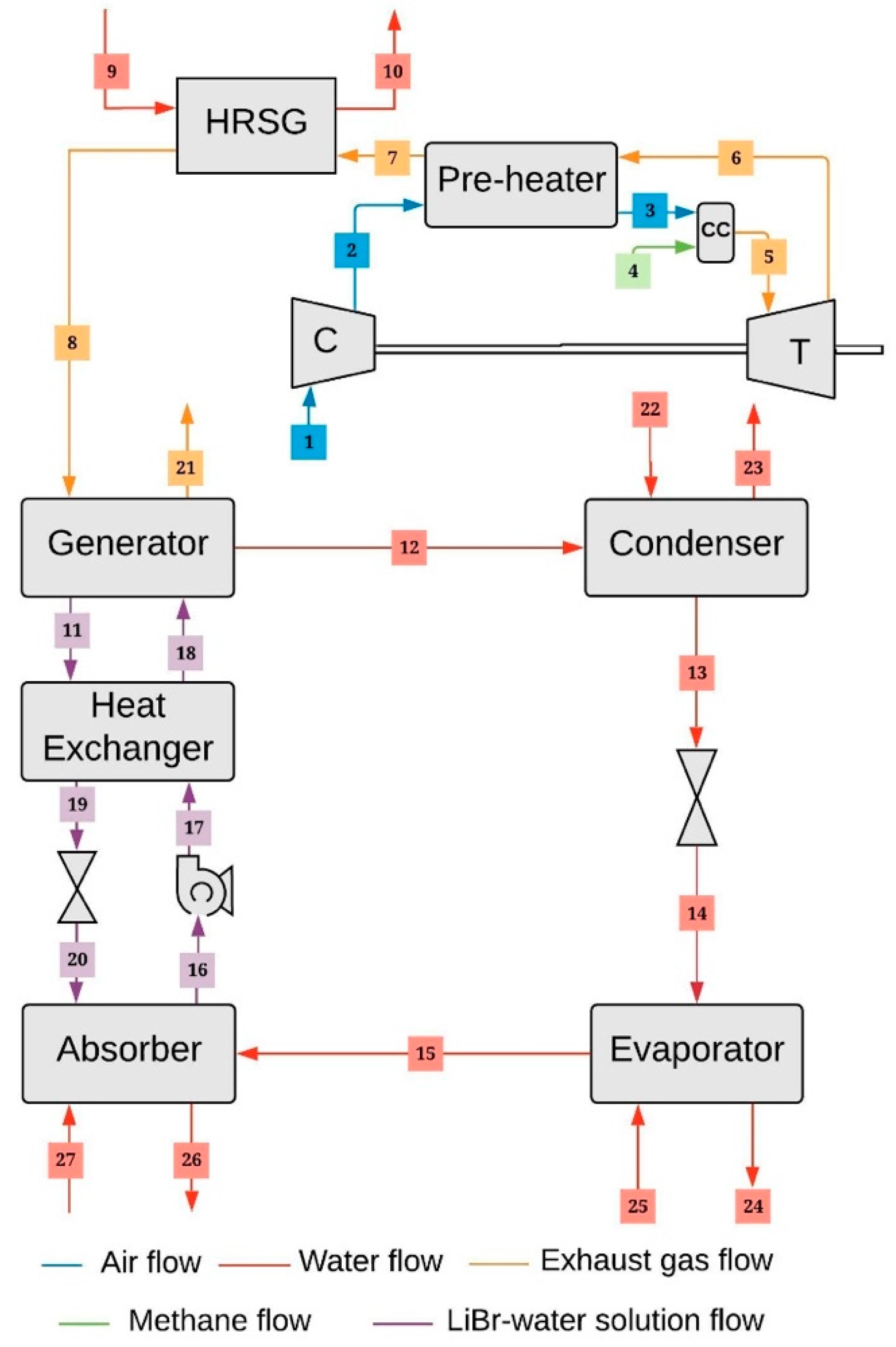
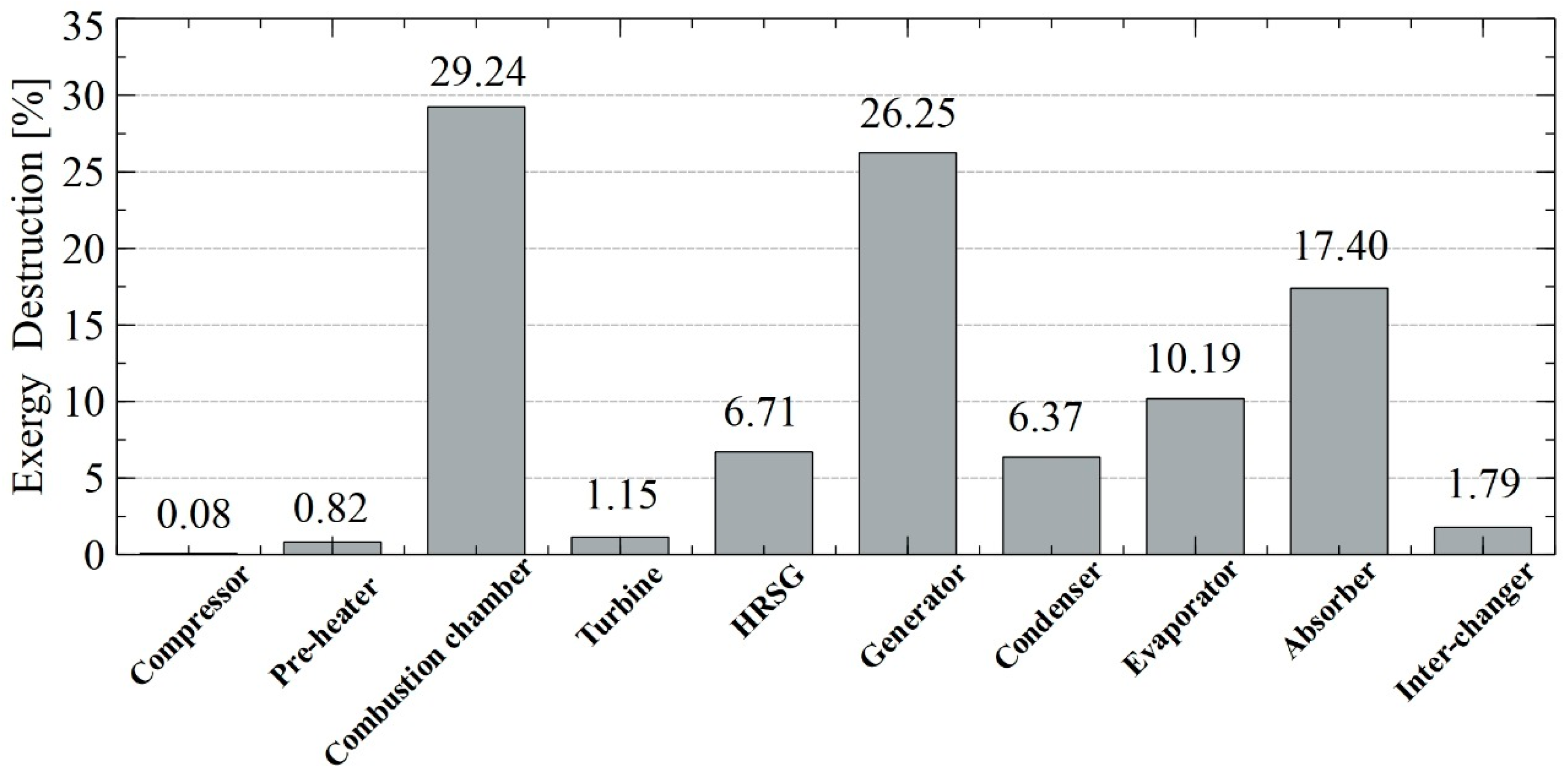
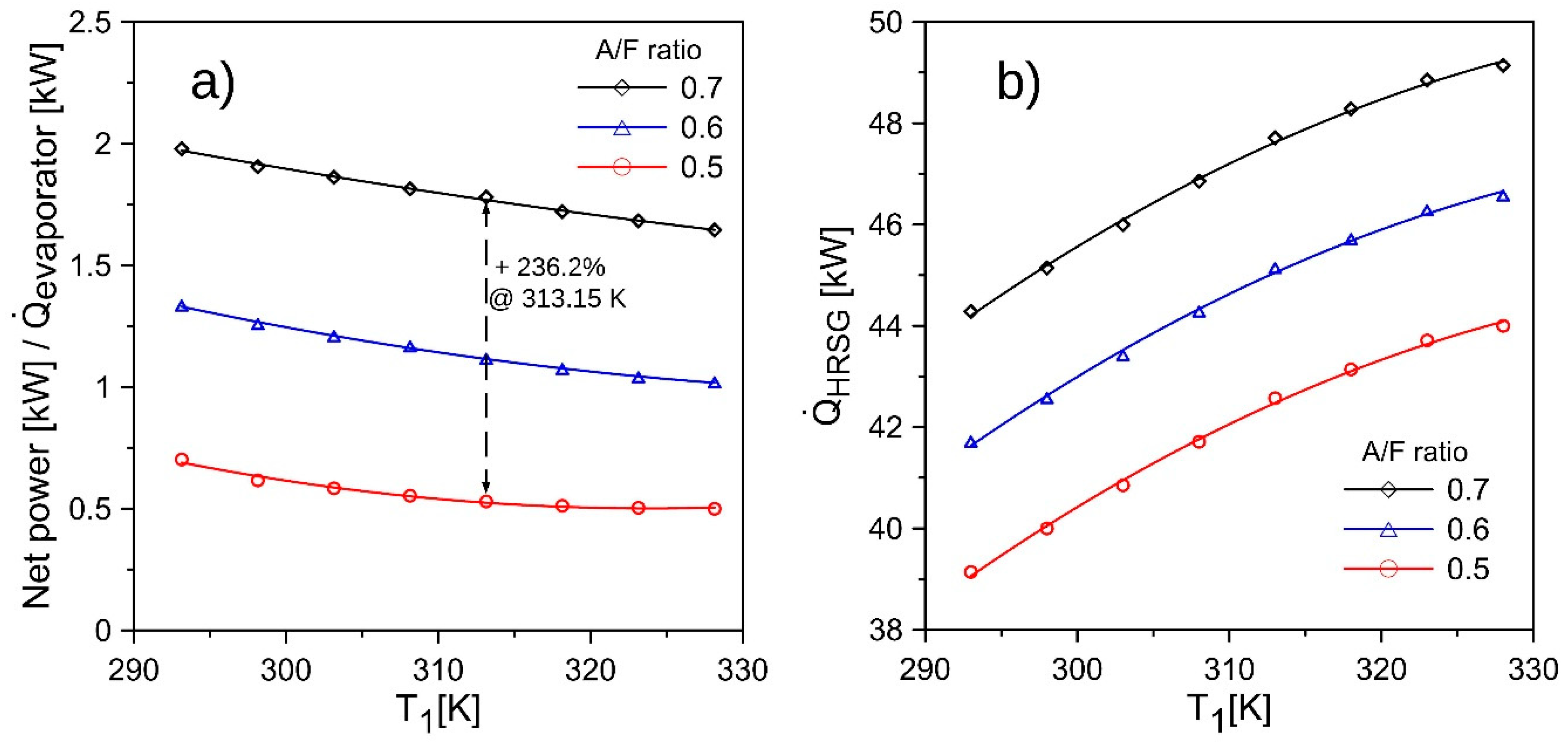
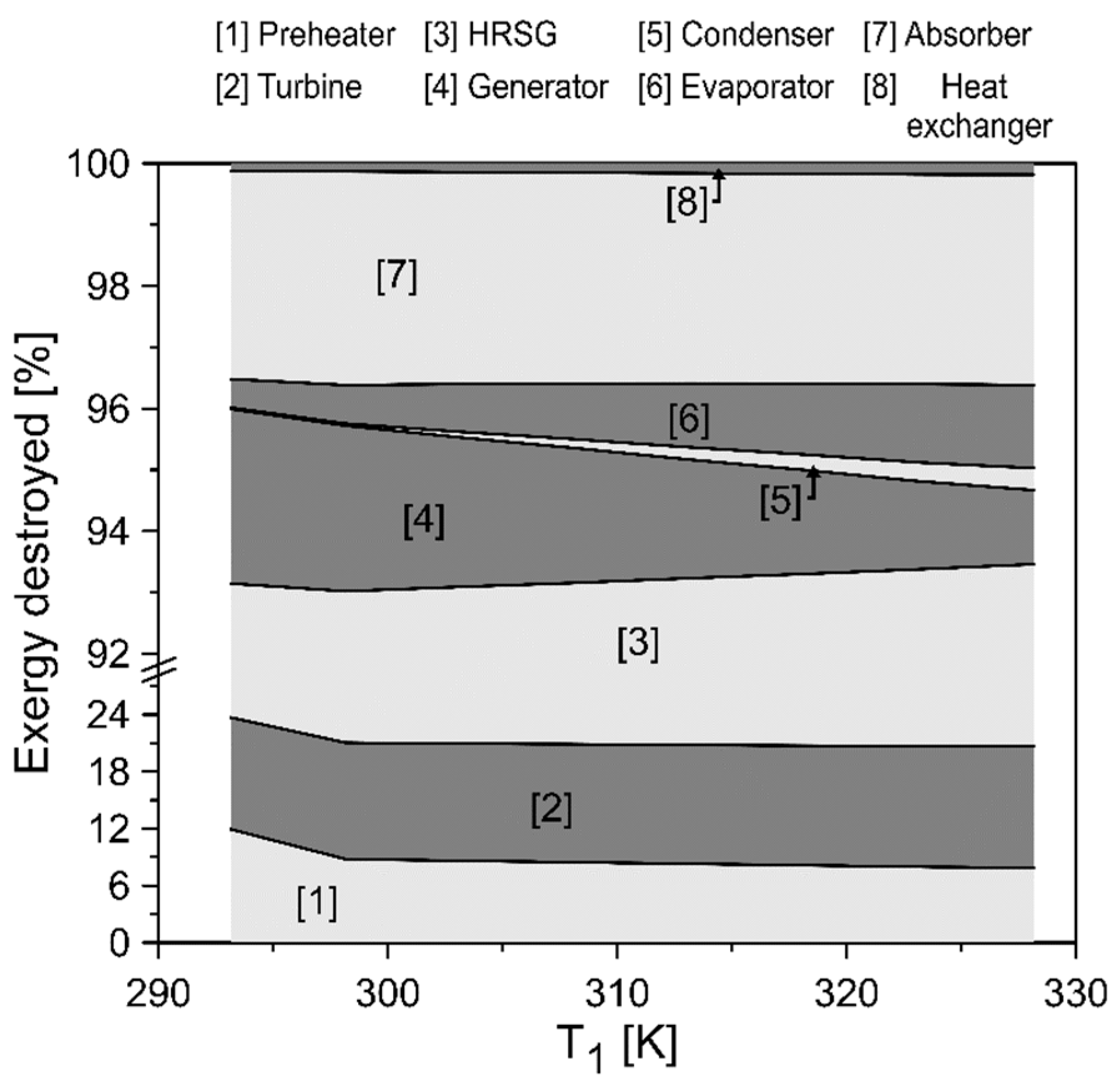
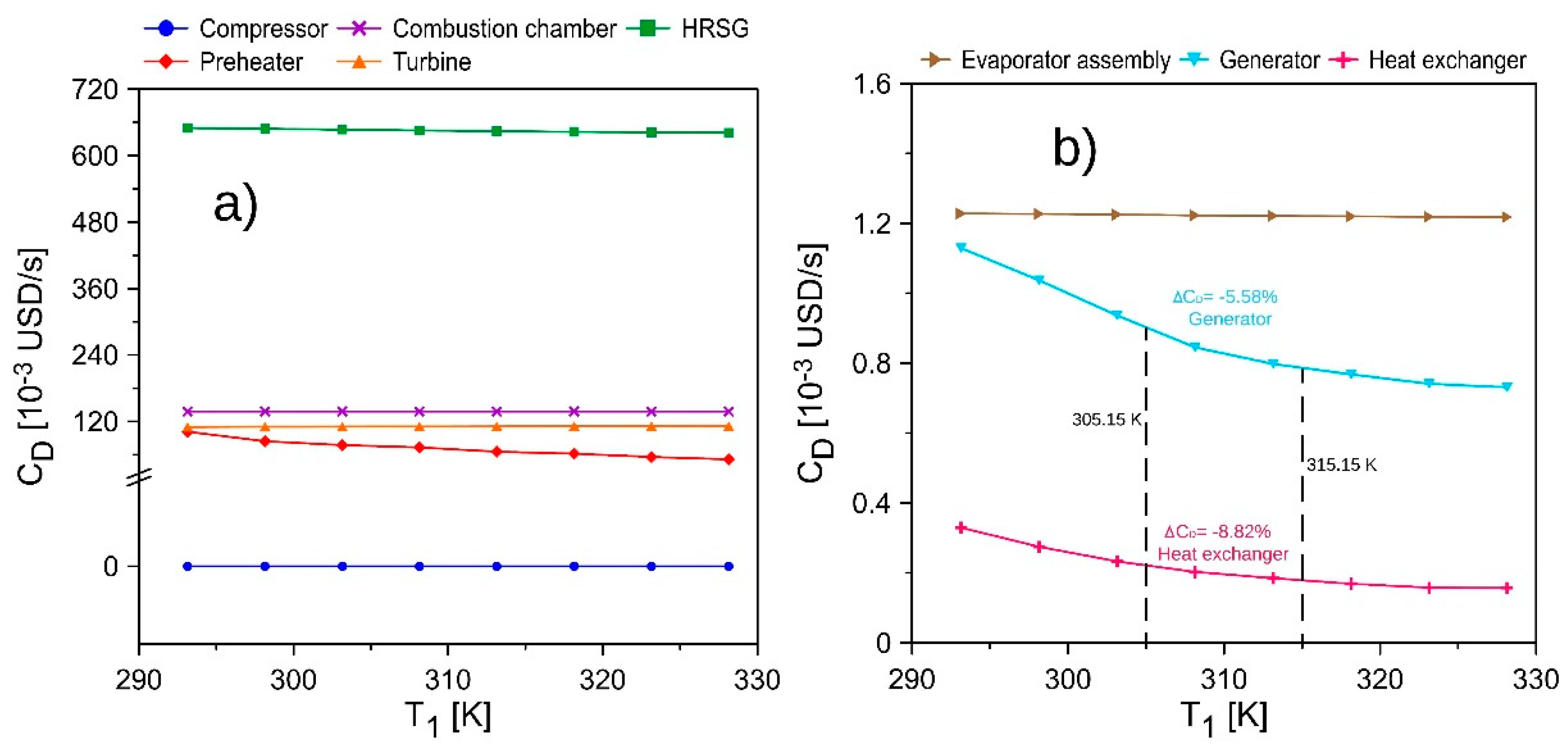
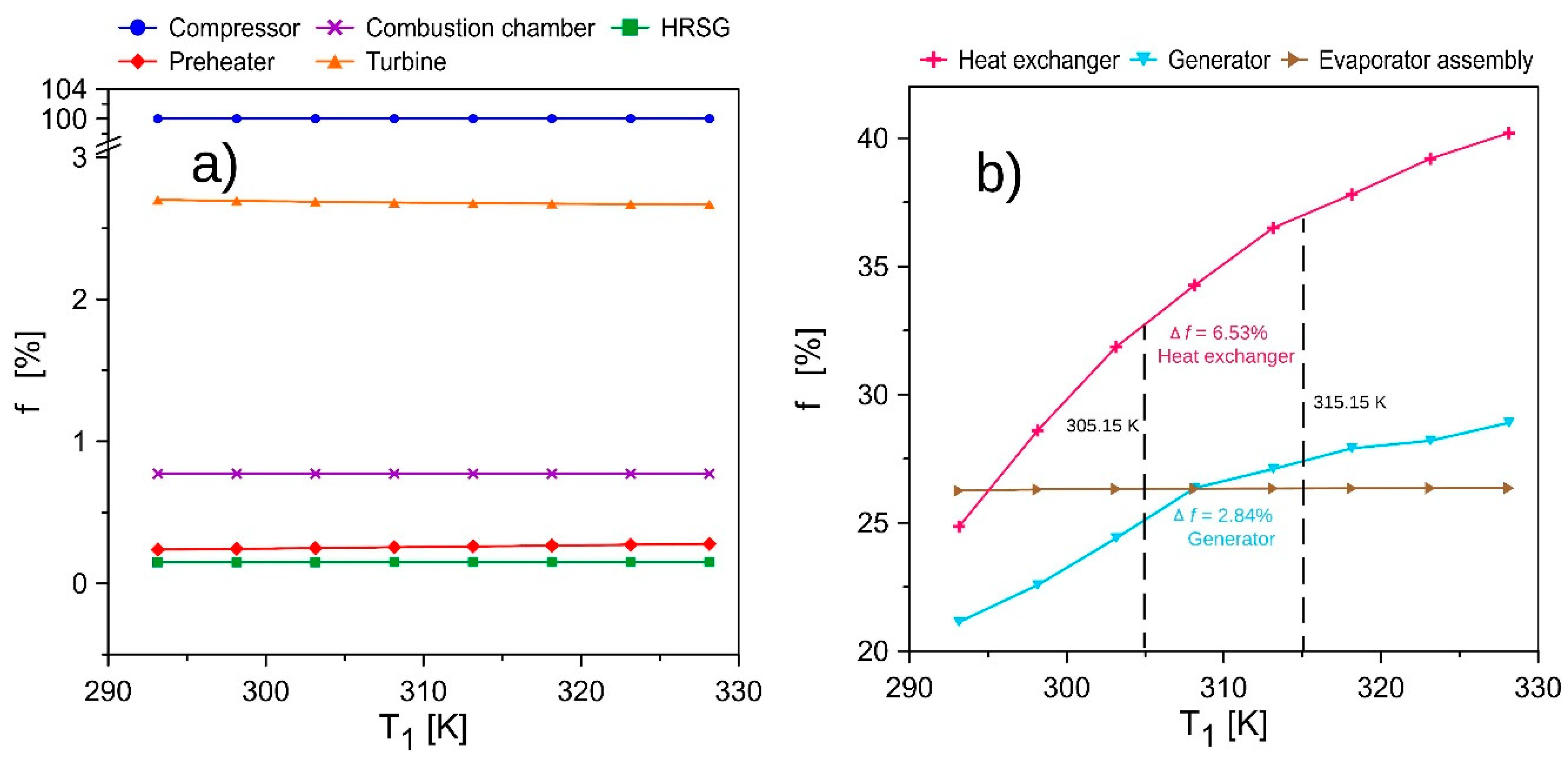

| Component | Energy Balance |
|---|---|
| Compressor | |
| Combustion Chamber | |
| Turbine | |
| Pre-heater | |
| HRSG | |
| Generator | |
| Condenser | |
| Evaporator | |
| Absorber | |
| Heat exchanger |
| Component | |||
|---|---|---|---|
| Compressor | - | ||
| Air pre-heater | - | ||
| Combustion Chamber | - | ||
| Turbine | - | ||
| HRSG | - | ||
| Generator | |||
| Condenser | - | - | |
| Evaporator | - | ||
| Absorber | - | ||
| Heat exchanger | - |
| Component | Cost Balance Equations | Auxiliary Equations |
|---|---|---|
| Compressor | ||
| Air preheater | ||
| Combustion chamber | ||
| Turbine | ||
| HRSG | ||
| Generator | - | |
| Heat exchanger | ||
| Pump | - | |
| Condenser | ||
| Absorber | ||
| Evaporator | - | |
| Solution expansion valve | - | |
| Coolant expansion valve | - |
| State | [kg/s] | [K] | P [bar] | [kJ/kg] | [kJ/kg·K] | [kJ/s] | [kJ/s] |
|---|---|---|---|---|---|---|---|
| 1 | 0.30 | 298.15 | 1.013 | 298.60 | 5.69 | 0 | 0 |
| 2 | 0.30 | 452.10 | 3.64 | 454.31 | 6.16 | 46.71 | 0 |
| 3 | 0.30 | 673.20 | 3.61 | 684.83 | 6.16 | 73.83 | 0 |
| 4 | 0.50 | 298.15 | 3.70 | -3.62 | −0.68 | 99.72 | 2.5919 |
| 0.80 | 829.10 | 3.61 | 216.40 | 7.69 | 305.40 | 4.24 | |
| 6 | 0.80 | 745.20 | 1.081 | 120.81 | 7.92 | 174.60 | 4.24 |
| 7 | 0.80 | 540 | 1.051 | −108.10 | 7.57 | 75.11 | 4.24 |
| 8 | 0.80 | 346.50 | 1.021 | −314.90 | 7.10 | 20.54 | 4.24 |
| 9 | 0.065 | 372.30 | 0.98 | 2651 | 7.36 | 29.85 | 617.50 |
| 10 | 0.065 | 298.15 | 1.013 | 104.81 | 0.36 | 0 | 0 |
| 11 | 0.57 | 346.50 | 0.059 | 167.91 | 0.44 | 23.60 | 0.62 |
| 12 | 0.019 | 346.50 | 0.059 | 2637 | 8.54 | 1.84 | 0.049 |
| 13 | 0.019 | 309.20 | 0.059 | 150.81 | 0.52 | 0.014 | 0.049 |
| 14 | 0.019 | 278.20 | 0.0087 | 150.80 | 0.54 | −0.13 | 0.049 |
| 15 | 0.019 | 278.20 | 0.0087 | 2510 | 9.024 | −3.49 | 0.049 |
| 16 | 0.59 | 307.20 | 0.0087 | 81.38 | 0.20 | 14.19 | 0.66 |
| 17 | 0.59 | 307.20 | 0.059 | 81.38 | 0.20 | 14.19 | 0.66 |
| 18 | 0.59 | 331.50 | 0.059 | 131.20 | 0.36 | 16.081 | 0.66 |
| 19 | 0.57 | 322.90 | 0.059 | 120.20 | 0.29 | 20.63 | 0.62 |
| 20 | 0.57 | 310.90 | 0.0087 | 120.20 | 0.22 | 33.51 | 0.62 |
| State | [10−3 USD/s] | [USD/GJ] | State | [10−3 USD/s] | [USD/GJ] |
|---|---|---|---|---|---|
| 1 | 0 | 0 | 11 | 3.18 | 25.73 |
| 2 | 89.53 | 532.4 | 12 | 0.42 | 24.27 |
| 3 | 198.50 | 746.9 | 13 | 0.014 | 24.27 |
| 4 | 139.21 | 1.48 | 14 | 0.017 | 24.27 |
| 5 | 338.70 | 303.88 | 15 | 0.75 | 24.27 |
| 6 | 195.61 | 303.87 | 16 | 1.39 | 26.14 |
| 7 | 86.81 | 303.89 | 17 | 1.48 | 27.80 |
| 8 | 27.12 | 303.88 | 18 | 1.86 | 30.89 |
| 9 | 60.67 | 303.90 | 19 | 2.85 | 25.73 |
| 10 | 0 | 0 | 20 | 3.61 | 25.73 |
| Equipment | r | f | |||
|---|---|---|---|---|---|
| Compressor | 24.80 | 24.87 | 0 | 0.0031 | 1 |
| Pre-heater | 30.22 | 30.27 | 79.13 | 2.67 | 0.0024 |
| Combustion chamber | 38.66 | 38.95 | 137.91 | 110.20 | 0.0072 |
| Turbine | 39.75 | 15.80 | 110.50 | 0.75 | 0.027 |
| HRSG | 16.58 | 16.85 | 648.51 | 0.91 | 0.0015 |
| Generator | 12.94 | 22.031 | 0.43 | 0.70 | 0.41 |
| Assembly evaporator | 26.35 | 132.70 | 1.11 | 4.30 | 0.28 |
| Heat exchanger | 27.15 | 65.77 | 0.15 | 1.42 | 0.41 |
© 2019 by the authors. Licensee MDPI, Basel, Switzerland. This article is an open access article distributed under the terms and conditions of the Creative Commons Attribution (CC BY) license (http://creativecommons.org/licenses/by/4.0/).
Share and Cite
Valencia Ochoa, G.; Acevedo Peñaloza, C.; Duarte Forero, J. Thermo-Economic Assessment of a Gas Microturbine-Absorption Chiller Trigeneration System under Different Compressor Inlet Air Temperatures. Energies 2019, 12, 4643. https://doi.org/10.3390/en12244643
Valencia Ochoa G, Acevedo Peñaloza C, Duarte Forero J. Thermo-Economic Assessment of a Gas Microturbine-Absorption Chiller Trigeneration System under Different Compressor Inlet Air Temperatures. Energies. 2019; 12(24):4643. https://doi.org/10.3390/en12244643
Chicago/Turabian StyleValencia Ochoa, Guillermo, Carlos Acevedo Peñaloza, and Jorge Duarte Forero. 2019. "Thermo-Economic Assessment of a Gas Microturbine-Absorption Chiller Trigeneration System under Different Compressor Inlet Air Temperatures" Energies 12, no. 24: 4643. https://doi.org/10.3390/en12244643
APA StyleValencia Ochoa, G., Acevedo Peñaloza, C., & Duarte Forero, J. (2019). Thermo-Economic Assessment of a Gas Microturbine-Absorption Chiller Trigeneration System under Different Compressor Inlet Air Temperatures. Energies, 12(24), 4643. https://doi.org/10.3390/en12244643







